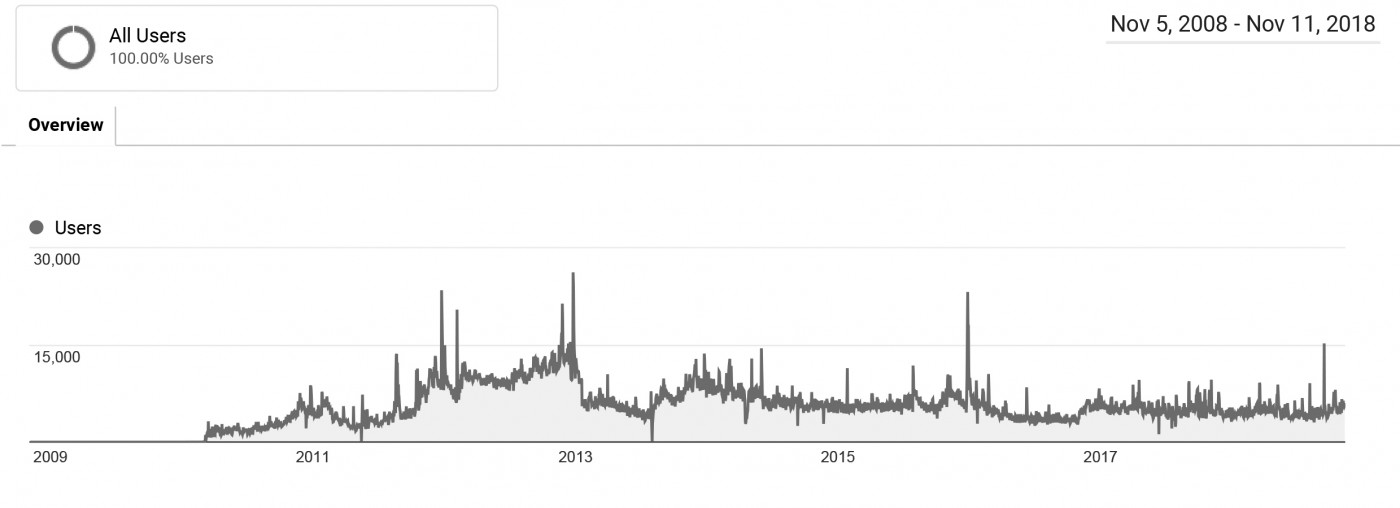e-Readers are becoming popular again in 2018
The modern e-Reader day e-reader industry started to take off in 2010 when dozens of companies were issuing handheld ebook readers
that utilized E Ink, which is the closest you can get to reading on real paper. Amazon and Barnes & Noble were making well over a billion
dollars a year selling hardware and the digital content. The height of the industry was from 2011 to 2014 and then it crashed.
Almost every organization involved in making alternative e-paper, e-readers and selling ebooks went bankrupt or allocated resources to
other divisions. The industry was in a holding pattern until 2017, when a series of advances were made and suddenly e-readers started
to gain steam again, 2018 seems to be the biggest year yet.
Good e-Reader has been chronicling the e-reader industry since 2007, the year the original Amazon Kindle was released.
It wasn’t until 2010 that we started to track metrics and website visitors using Google Analytics. Our website is the most popular in the world
when it comes to daily e-reader news and comprehensive unboxings and reviews, so our metrics read like a playbook for the overall industry.
You can see the years in which traffic spiked, primarily because of global interest. You can see from the graph that from 2015 to early 2017
there was not much interest in e-readers but in late 2017 and all of 2018 things are beginning to pick up steam again.
You might have noticed little spikes here and there. After investigation I found that these correlate directly with new Kindle models
coming out. The smaller spikes are when Kobo and Nook e-readers are officially announced or when we conduct reviews.
Also it is important to note that e-reader interest is determined not only from our website, but the health of other e-reader review websites
and the communities. It is hard to gauge specific sales because Amazon never discloses Kindle sales, Kobo does not release financial
data and their parent company Rakuten hardly ever mentions them. B&N sales data is normally available due to them being a publicly
traded company and SEC filings. Private companies in the e-reader space never release financial results, but E-Ink does. E-Ink has been profitable for the past four years and every year they continue to generate more revenue from the year prior, which is very telling.
One of the big reasons why the e-reader industry is undergoing a resurgence is because technology has improved. Waterproof/dustproof
and big screens are the norm. You can find really solid front-lit technology in virtually every device and most of them now have color
temperature displays that help mute the bright white LED lights. Some models have ambient light sensors to automatically do this based
on your environmental lighting and others need manual adjustments.
Hardware has dramatically improved as well. Many e-reader companies are releasing new devices with a dual-core, quad-core or
octa-core processors and went from 512MB of RAM to over 2GB, which increases performance. Screens now come in all shape and sizes,
you can find many six inch models and they go all the way to 13.3 inches. Some of these bigger devices come with stylus support and professional note taking features, to replace paper in an office setting.
There might be fewer companies involved in the e-reader space, but all of the remaining companies are either successful regional players
such as Bookeen, Storytel, Icarus, Arta Tech or Pocketbook. Some former regional players managed to break out and expand due to
alternative distribution and retail methods, such as Onyx Boox and Boyue. Amazon and Kobo are the largest global players and B&N
continues to sell content, but they normally operate at a loss, or eek out just a few million per year.
I believe the interest in e-readers is starting to gain momentum again. I believe this is due to a few reasons. Most people who initially
purchased an e-reader from 2011 to 2014 are looking to upgrade their older devices to something new. This could be due to waterproof
being the norm and the front-lit displays becoming more prevalent and reliable. Some like they can now listen to audiobooks and others
enjoy the Android experience. Others love there is more variety of different sized screens, after reading for years on a six inch screen,
buying a model with an eight inch one is heaven scent. Whatever the reason, the interest in e-readers is growing again, which is a good
sign for the overall health of the industry. People are buying more, doing competitive research and doing their due diligence.]
We might never see the glory years of the e-reader industry again, primary due to smartphones and tablets and whatever comes next.
There will always be a niche market for a handheld and portable ebook reader that is easy on the eyes and have a singular purpose.
I am glad that they are picking up steam again and there seems to be some attempt at innovation. We might get back to the levels from
2011 to 2014 once color e-paper becomes a thing.
2018 e-Reader trends
Kindle Paperwhite 4 with waterproof and Audible Support is released
Amazon offers 8GB and 32GB on some models
Kobo Clara HD and Kobo Forma e-readers are released
Overdrive support comes to all modern Kobo e-readers
More E-Readers now have color temperature screens
Tolino releases the Shine 3
Kindle Oasis 2 is confirmed to have an IMX.7 dual core processor
Many different digital note taking devices are released, close to 12 in total
Over 28 new e-readers are released in 2018
Android GO apps make Android e-readers more viable
Most Android e-readers lose Google Play support due to Google Play crackdown on unauthorized devices
Quad-core and Octa-core e-readers have come out, more RAM and Storage.
There is a an e-reader for everyone now, lowend, medium, high-end and for professionals
November 12, 2018 By Michael Kozlowski
